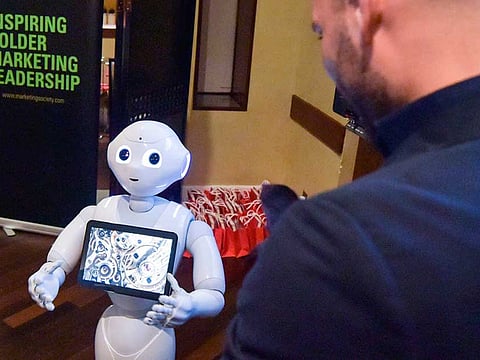Time to get a robot to do the selling
UAE marketers get a first glimpse of the humanoid robot Pepper

Dubai: Even in a world dominated by digital media campaigns, a robot can still have its uses. The region’s marketers will soon be finding out whether this is so through “Pepper”.
The robot — which can “perceive emotions” — has already been deployed at Carrefour stores in France, where it “meets-and-greets” shoppers.
As a means of getting their attention, it certainly played its part. (You can even take Pepper home, as in Japan, where it has become the first “humanoid robot to be adopted in homes.)
But can robots really be expected to do much more than meet-and-greet in a consumer-facing experience? And what happens when the novelty wears off?
“We can imagine robots taking care of an initial level of a specific relationship ... with the ability to serve a higher number of people, in a shorter time and with a better average quality for tasks that are simpler,” said Alex Brunori, Creative Head at Google MENA.
“Humans could focus on the deeper and more important level of the relationship, where their skills and experience is irreplaceable.
“Depending on the programming, it [robot] could be used in mass marketing or for specific industries, or even with a more in-depth focus on specific tasks within a specific industry. Its humanoid features and ability to understand emotions and interact accordingly suggest a consumer-facing role rather than a purely automated one.
“It could also be used on a different and less commercial level to help assist ill or disabled people, or in health care and education facilities. The range of possibilities is wide.”
Pepper — developed by Aldebaran Robotics and SoftBank Mobile — is being brought to this market by Yas Digital Media. It had its first public exposure at the Marketing Society’s meeting in Dubai earlier in the week.
“We have many vertical markets identified and working to develop solutions with our clients for these vertical marketplaces,” said Mark Leo, Director — Client Service at Yas Digital Media. “We are working with several local and global brands in the market ... and booked until the end of September with interactions, project scoping and project delivery.”
According to Alex Malouf, a marketing communications professional working in the FMCG industry, adjusting to robots in a retail or marketing environment might need some getting used to for regional consumers.
“Consumers will have to get used to interacting with a humanoid,” said Malouf. “But in any environment where there is interaction between two parties — be it government, transportation, retail or service — robots have their uses. They are very adaptive and you could reprogramme a robot much more easily than you could do with humans.
“You can programme a robot in terms of language. You could change their shape and their form. You will find that children particularly like to deal with robots; they like to ask them questions or play with them. In terms of adoption, we will see it becoming commonplace ... but it’s going to take time to become mainstream.
“I think the big change will be to the marketing function, because robots take all of the interactions they have had and retain data, which can used by marketers to understand how the interaction went. This can be used to programme the robot, change the store layout and design, or change products.
“For example, they can even inform the operations team immediately if a product is out of stock ... so for the back-end there are many positives. And it will change the way we as marketers work.”
But what of the human element? Is this about to be ditched?
“We see our customers continuing to seek genuine human interaction ... this does not exclude a role for technology as this interaction might be facilitated — even augmented — by tech (a Skype-style conversation conducted on-screen or a staff member equipped with an iPad, for example,” said Matthew Horobin, Head of Digital Media, Dubai Airports.
“That said, I would expect this to change over time as mass tech fluency and familiarity grows. But, right now, our customers seek out authentic human engagement.
“Perhaps a more realistic role for humanoid support today would be to support/supplement this human workforce, ‘fetching and carrying’ on behalf of their human counterparts and ultimately freeing them up to deliver the best possible front-end experience without having to worry about lower-value ‘backstage’ fulfilment activities and actions.”
Sign up for the Daily Briefing
Get the latest news and updates straight to your inbox


